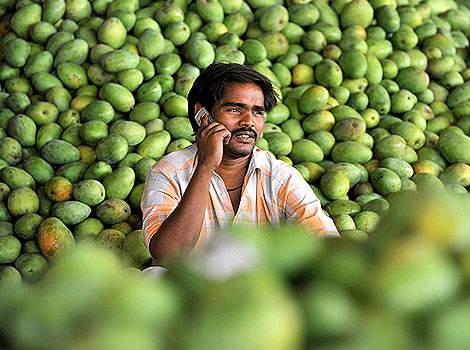20 May, 2018; New Delhi

Look and you’ll see an exciting landscape emerging in the banking arena. One where there is a billion-strong market actively seeking financial services but remains largely unattended to. These globally distributed prospective customers represent enormous earning potential for banks, but constitute the unbanked.
The unbanked are those who do not utilise banking services and have limited banking needs. The unbanked are not the poorest of the poor. However, they certainly include those whom banks need to serve but cannot do so profitably in the existing banking environment. Though these consumers need access to banking for savings, loans and microfinance, they do not have bank accounts. The reasons for this are compelling.
-
Lack of steady and substantial income leading to a fear of insufficient funds for an account
-
Limited access to banks, especially in remote areas
-
Lack of formal employment that precludes a financial history
-
Poor financial literacy
-
Psychological factors such as mistrust of financial institutions
This unbanked billion is not outside the banking sector by choice. An important reason for their predicament is that banks do not offer them suitable products tailored to their needs. In effect, they have been excluded by the banks’ inability to understand their requirements and the unwillingness to adopt innovative models to serve them.
However, this billion also constitutes an enormous opportunity if banks are willing to accept the challenge of including them with an eye on the bigger picture. This paper provides a regional perspective to this issue and examines what banks can do to capitalise on this opportunity.
How to bank the unbanked
In China and India only about a third of the population participates in the formal banking sector. In Africa the number is just 25 percent. India has the second-highest number of financially excluded households in the world 135 million after China’s 263 million. Africa as a whole has 230 million unbanked households, and Central and Eastern Europe and Latin America have 19 million and 42 million, respectively.
But irrespective of where in the world they might be, this unbanked section of society has similar needs for financial services. Apart from the obvious requirements of savings, loans, transactions, and investments, the unbanked have certain special needs, which are:
-
Flexibility in savings and repayment schedules owing to a lack of steady income
-
Simplicity and speed in processing
-
Small product sizes when it comes to loans and low-balance savings accounts
-
Proximity and ease of access
-
Basic financial education or information since the unbanked may not understand even elementary concepts of banking
Most banks find it difficult to meet these needs because of the high economic cost of servicing these demands. However, a little out-of-the box thinking in devising products that are simple and accessible can help ensure inclusive growth.
Some of these measures could include tying up with an NGO or with a retailer and using village residents and empowerment groups as representatives. These can lower customer acquisition costs and increase customer base, thus helping banks overcome the high cost challenge. Such groups also help banks mitigate risks associated with dealing with the unbanked. An estimated 2.6 million self-help groups in India are linked to banks, giving financial institutions access to 40 million households.
It is important that the products are downsized without being downgraded to match the unbanked population’s smaller requirements by offering low installments and flexible repayment options. Banks also require performance metrics and regulatory conditions that are more suited to including the unbanked in the financial mainstream.
Some banks are using inter-industry partnerships to increase financial inclusion. For example, banks in Brazil have added 100,000 point-of-sale locations to distribute products by tying up with retailers. Not only are these channels cheaper for banks but they are also more convenient for consumers.
Banks must realise and they are seeing the light that since the unbanked have remained unaddressed by traditional financial institutions, they will not hesitate to choose newer players for basic banking services such as payment and deposit transactions. Collaborating with telecom players, adding a mobile channel, and utilising cross-selling opportunities will go a long way in meeting the needs of the unbanked.
In many emerging economies, mobile consumers are growing at a much faster rate than bank customers. Mobile banking is taking off because it is convenient, fast, simple, and secure. Moreover, it is a cost-effective option for banks. There were 33 million mobile payment users worldwide in 2008, with the Asia Pacific taking the lead. We can expects this number to triple to 103.9 million users in 2013.
Other forms of branchless banking and e-payment gateways such as payment cards and the Internet can also help banks increase their outreach. Banks need to experiment and include the next billion consumers not merely for the socio-economic assistance they will gain. The step will also have a strong business imperative for banks. Not only will a bank increase its customer base, but it will also ensure increasing numbers of future customers as incomes increase.
Let us examine how banks are reaching the unbanked in various parts of the world, namely, India, China, Eastern Europe, parts of Africa, and Latin America.
India
Concerns on the front of income distribution and poverty alleviation cannot be met without full-scale expansion of banking and other financial services. Indian growth story as impressive, there were concerns on issues like income distribution and poverty alleviation, where lot remained to be done.
India ranks 119th among 169 countries on the 2010 Human Development Index published by the United Nations Development Programme.
India has issues of water, sanitation, power, infrastructure and environmental degradation. More importantly, there are issues of social and economic inequalities and multiple deprivations.?? Inclusive growth is impossible without financial inclusion and successful implementation of government schemes in achievement of its goals in the Eleventh Five Year Plan were impossible to achieve, without access to the banking sector. The rationale behind this is that access to finance, along with fair and transparent products and services, is a source of empowerment and allows people to participate more effectively in the economic and social process.
Building more branches in the countryside may not always be cost-effective. So banks need to explore other options by developing a better understanding of what rural households need and offer new products and distribution networks to suit them.
Providing banking services through ?Banking Correspondents? represented by self-help groups, NGOs and other approved organisations is one branchless banking mechanism. Touch-points may be set up by such organisations at places commonly visited by the unbanked, such as the village markets or schools. This may be supplemented by outreach teams equipped with hand-held devices on which simple banking transactions can be performed.
Mobile banking is another way of reaching out to such customers and is also a huge opportunity for banks in India. According to a TRAI report, the total number of mobile subscribers by March 31, 2008 was 261.08 million as against last year’s 165.09 million (an increase of 58.14 percent). This figure shows that in just three years, the number of mobile subscribers has grown over 4.5 times.
India is adding more subscribers per month than any other country. According to the GSM Association (Global Association for GSM Providers), the next billion subscribers will come from the BOP (Bottom of the Pyramid) market, of which India will have the largest share. The growth of mobile phone subscribers is outpacing the growth of banking customers as also PC and Internet users in India.
Banks are looking at technology to provide banking services at low cost and this includes rural banking too. Citi has set up a bio-metric ATM as a part of its no frills Pragati account for the under-banked. The ATM recognises the customer through their thumb impression and can interact in regional languages.
China
Estimates about the numbers of unbanked Chinese vary. The People?s Bank of China (PBC) estimates that only 36 percent of Chinese rural households have access to financial services. As one indicator of demand, the informal finance market has been estimated at anywhere between CNY 1 trillion ($132 billion) to CNY 2 or 3 trillion.
But the bigger Chinese banks have for many years now been moving out of rural areas, goaded by commercialisation and competitive pressures. According to the State Council Development Research Centre (DRC), the four big state banks have reduced their presence in rural areas by over 43 percent in ten years, closing 30,000 branches in the last five years alone.
The Chinese government has launched several initiatives to test out new forms of rural financial service providers.
Among them:
-
The People?s Bank of China in December 2005 launched a pilot initiative to establish Microcredit Companies using commercial licensing
-
The China Banking Regulatory Commission in December 2006 introduced their own pilot, creating new types of licenses for rural financial institutions
McKinsey believes that given the reliance on cash in rural China and that additional ATMs do not appear to be the answer, the existing mobile Short Message Service network could quickly and cheaply provide an SMS-based payment system in rural areas. Since the most expensive parts of the infrastructure the network and phones are in place, this solution would be relatively low in cost, between $40 million and $60 million. By forming a partnership, banks, network operators and merchants could unlock spending.
The Chinese largely rely on cash payments, thus increasing the importance of the cash-based e-payment channel. Some leading third-party payment providers are adding cash-based and non-bank based payment options to their offerings. These include:
-
Cash remittance:?Alipay is a third-party payment provider, allowing users to top up accounts with cash through China?s postal service. This service was launched in March 2007 in selected China Post braches throughout China.
-
Mobile toll stations: Smartpay, China’s leading mobile top-up company, has formed a network of approximately 30,000 dealers. Smartpay dealers allow users with bank accounts to easily use Smartpay?s services, which in turn gives Smartpay access to a much wider range of potential users.
-
Targeting the unbanked with pre-paid cards: e-payment player IPS uses mobile and telephone prepaid cards in order to reach unbanked users. This service takes advantage of the popularity of prepaid top-up cards used for phone bills, online games, and virtual currencies in China. The cards are usually purchased with cash at newspaper kiosks, small shops, and internet cafes. IPS operates a service called Ipay.
Eastern Europe
In Poland, only 50 percent of the country’s population has a bank account, according to ING Group. Banking penetration was 69 percent in Hungary at the end of 2003.
Many East European (EE) residents avoid setting up bank accounts because they lack confidence in the banking system. This mindset is gradually changing as governments encourage salary payments directly into bank accounts.
Austria’s Erste Bank has the largest network in the region and intends to target the unbanked in Hungary, the Czech Republic, Croatia, Serbia and Romania. Western banks in EE are focusing on meeting the needs of the younger population. In Poland, only 49 percent of people over the age of 15 have a bank account, according to Polish research company Pentor.
Almost 40 percent of Poles who participated in a recent banking survey attributed the low level of banking penetration to their lack of savings. Only 5 percent of Polish people use Internet banking, against an average of 24 percent in Europe as a whole; 4 percent of Poles use telephone banking services compared with 7 percent in Europe, according to Forrester Research.
To make it easier for Poles to access banking products, ING Bank Slaski, the Polish operation of ING Group, has simplified some products. The new offerings include a savings account which offers one flat interest rate and a low-interest credit card.
Plastic card technology is expected to present the banking industry with an important means of tapping the unbanked market.
Similarly, post offices, which constitute more than 50 percent of the physical infrastructure for access to the financial sector, could provide an innovative POS alternative to reach out to the unbanked.
Africa
According to the IMF, African countries are enjoying their best period of sustained economic expansion since attaining independence. Still, only 20 percent of families in Africa have bank accounts.
Ethopia has less than one bank branch per 100,000 people a developed nation like Spain has an average of 96 branches. Even in South Africa, where the sector is more sophisticated, only 40 percent of adults have bank accounts. But there is a huge demand for bank services. Finding this demand unfulfilled, millions of Africans turn to informal services or invest in cattle.
But banks are increasingly adopting innovative methods. South Africa has physically taken branches to the unbanked, either as prefabricated units, or in vans that make visits to under-served areas. In remote areas, machines have been installed in shops where customers print out a slip and present it to the shopkeeper, who provides the cash. Some rural branches and ATMs rely on solar energy and satellite phone.
The Big Four banks of South Africa (ABSA, First National Bank, Nedbank Group and Standard Bank) and the government developed the innovative Mzansi account in 2003 which is a low-cost transaction account. It enables banks to cover at least 70 percent of the unbanked market in a relatively short time. The government provided a small subsidy to cover the cost. It is targeted at people who earn less than R2,000 (US$264) a month. It now has more than 4 million subscribers.
Studies conducted by Genesis Analytics for the Finmark Trust have suggested that point-of-sale (POS) facilities can play an increasingly important role in providing the unbanked access to basic financial services in South Africa.
West African financial services biggies Zenith Bank and Ecobank and multinationals Citibank and the International Finance Corporation have set up the Accin Microfinance Bank in Nigeria. It aims to provide low income earners and entrepreneurs with credit facilities and finance.
Mobile banking seems to be the most promising option in Africa. Few Africans may have bank accounts, but many have mobile phones. Wizzit (a financial services provider), First National Bank (FNB) and MTN Banking (a joint venture between Standard Bank and a mobile-phone network), are targeting the 14 million unbanked South Africans.
In Kenya and Botswana, 17 percent of the unbanked own a mobile phone, according to the FinMark Trust. In Kenya, Vodafone and Safaricom, Kenya’s leading mobile operator, launched an m-commerce payment service, M-PESA, aimed at the unbanked in March 2006. Within three months, it had 150,000 customers, with 2,500 new users signing up each day.
First Bank linked-up with Nigeria?s second biggest mobile operator, Globacom. The partners introduced the GloFirst card in conjunction with the switching company Interswitch. GloFirst can be used to withdraw money, check card balance, print mini statements, change the Personal Identification Number (PIN) and transfer money to another cash card or bank account.







